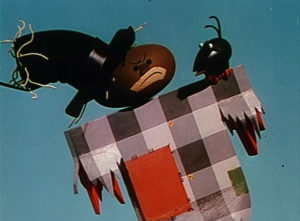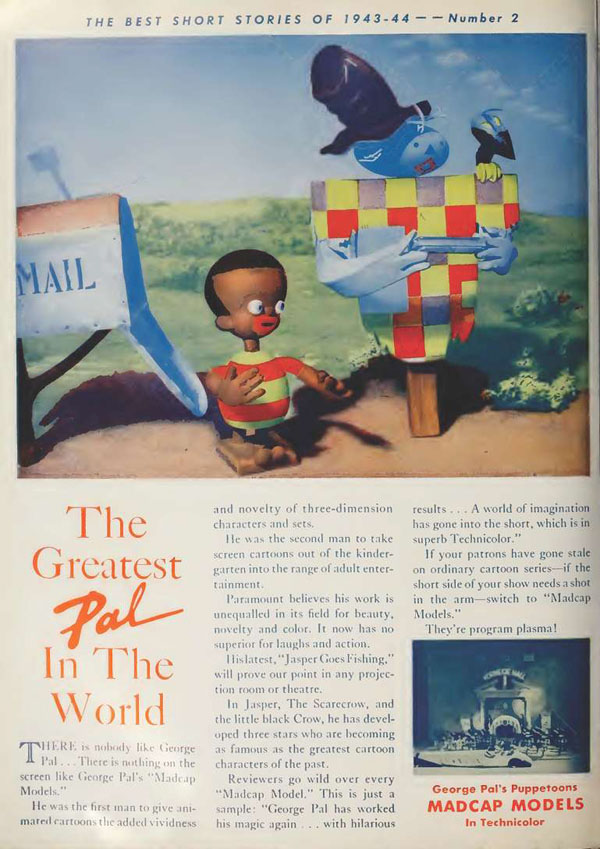
George Pal and his cast of characters
In 1943 Paramount Pictures realized that it had a popular hit character in producer/director George Pal’s animated African American Sambo-figure “Jasper”. The studio wasted no time capitalizing on its success. That fall, for the 1943-44 movie season, Paramount promoted Jasper as not only the headliner of the “Madcap Models” series but also as the distributor’s major animated star overall. In a full-page, full-color print advertisement for trade magazines, Paramount boasted, “In Jasper, the Scarecrow, and the little black Crow, [Pal] has developed three stars who are becoming as famous as the greatest cartoon characters of the past.”
The notice also praised Pal: “Paramount believes his work is unequalled in its field for beauty, novelty and color. It now has no superior for laughs and action.” That particular passage must have rankled the staff of Paramount’s own animation facility Famous Studios, which was producing “Popeye,” Superman,” “Noveltoons,” and “Little Lulu” at the time. After all, if the Puppetoons were “unrivalled” for “novelty,” what did that mean for “Noveltoons,” which promised animated novelty to audiences? Nevertheless, Paramount placed its bet on Jasper as the studio’s new animated icon.
 Pal’s three “Jasper” cartoons of 1943 stuck to the winning formula from the previous year. In this formula, Scarecrow and Blackbird would lead Jasper to mischief, and the audience is treated to a surreal dream or nightmare associated with the scheme. Jasper and the Choo Choo finds the protagonist unwittingly gambling with Scarecrow; the “Choo Choo” refers to a train whose cars consist of multiple dice. In the dream sequence, the surroundings are all made of dice–including the ground. In Jasper’s Music Lesson, the Scarecrow tries to convince Jasper to practice playing boogie-woogie instead of classical music; Jasper’s “Mammy” appears on screen for the first time to put a stop to the antics. Finally, Jasper Goes Fishing is a lesson against truancy from church, because Jasper goes fishing with Scarecrow instead of attending Sunday School and suffers an underwater nightmare when doing so.
Pal’s three “Jasper” cartoons of 1943 stuck to the winning formula from the previous year. In this formula, Scarecrow and Blackbird would lead Jasper to mischief, and the audience is treated to a surreal dream or nightmare associated with the scheme. Jasper and the Choo Choo finds the protagonist unwittingly gambling with Scarecrow; the “Choo Choo” refers to a train whose cars consist of multiple dice. In the dream sequence, the surroundings are all made of dice–including the ground. In Jasper’s Music Lesson, the Scarecrow tries to convince Jasper to practice playing boogie-woogie instead of classical music; Jasper’s “Mammy” appears on screen for the first time to put a stop to the antics. Finally, Jasper Goes Fishing is a lesson against truancy from church, because Jasper goes fishing with Scarecrow instead of attending Sunday School and suffers an underwater nightmare when doing so.
The 1943 cartoons repeat the faults of Jasper’s debut year. Ethnic stereotypes abound in the plantation imagery, the costuming of the “Mammy,” and the dialect. Lines like “You don’t get nothin’ from nothin’,” “the sourest plain’ I done ever hear’d,” and “I’s practicin’ my song for Sunday School” are in these films. Also, the episodes barely build stories from the most familiar of African American tropes during World War II: a crapshoot, boogie-woogie music, and call-and-response choral singing. The crapshoot is an ethnic stereotype, but the two other tropes saw frequent exposure to mainstream wartime audiences. By this time producer Walter Lantz produced a series of cartoons devoted exclusively to boogie-woogie (“Swing Symphonies”). Meanwhile, the African American choral group the Hall Johnson Singers performed call-and-response in live-action movies such as Cabin in the Sky.
 Pal’s 1943 “Jasper” films have some strengths. The interplay between the Scarecrow and his blackbird sidekick is humorous, thanks in large part to Roy Glenn’s vocal and comedic talents. The visuals are creative, as when each “five” face on the dice turns into a nose, mouth and pair of eyes. Unlike the previous year, the soundtracks do not use choral singing as a narrative crutch. In fact, only Jasper Goes Fishing relies on choral singers, because church singing is part of the story itself.
Pal’s 1943 “Jasper” films have some strengths. The interplay between the Scarecrow and his blackbird sidekick is humorous, thanks in large part to Roy Glenn’s vocal and comedic talents. The visuals are creative, as when each “five” face on the dice turns into a nose, mouth and pair of eyes. Unlike the previous year, the soundtracks do not use choral singing as a narrative crutch. In fact, only Jasper Goes Fishing relies on choral singers, because church singing is part of the story itself.
Just three of the ten “Puppetoons” of 1943 starred Jasper, but the African American boy dominated Pal’s output after that year. Due to the intricacies of puppet-animation, each episode took longer to produce than hand-drawn animation. Therefore, despite Paramount’s praise of Jasper, the distributor offered far fewer of his episodes than of “Popeye” or even the last season of “Superman,” which consisted of four releases in 1943. For the time being, Jasper would have to be a rare treat for audiences.



 Christopher P. Lehman is a professor of ethnic studies at St. Cloud State University in St. Cloud, Minnesota. His books include American Animated Cartoons of the Vietnam Era and The Colored Cartoon, and he has been a visiting fellow at Harvard University.
Christopher P. Lehman is a professor of ethnic studies at St. Cloud State University in St. Cloud, Minnesota. His books include American Animated Cartoons of the Vietnam Era and The Colored Cartoon, and he has been a visiting fellow at Harvard University.



























And it’s a shame that none of these Puppetoons are available anywhere. “Jasper Goes Fishing” sounds like “Sunday Goin’ To Meetin Time” meets Little Lulu’s “A Bout With A Trout”!
Why aren’t these films allowed on YouTube? Arnold Lebovit just owns the Puppetoon trademark – not the films themselves. I’m sure people can explain the difference between a “copyright” and a “trademark”!
For the record, I believe every public domain Puppetoon is on Lebovit’s PUPPETOON MOVIE blue ray and DVD compilation. Most all other Puppetoons are protected by copyright and no one – except the copyright holder, Paramount Pictures – can legally post those cartoons to You Tube or any video sharing site. To his credit, Lebovit is currently working with Paramount to restore and release the rest of the Puppetoons in the (hopefully) near future.
Here’s hoping that there’s another Puppetoons Blu Ray in our future.
This is another one of your excellent posts, Mr. Lehman. I enjoy your informative and straight-to-the point writing style.
Thank you, Jazz Man. I do my best.
I must echo the praise here to Mr. Lehman for these in-depth posts on these seldom seen cartoons and why they are seldom seen. All I can add is that the over-zealous article promoting the PUPPETOONS as superior to all other animated works of the period is merely because of the type of animation which was probably seldom seen. Sure, there was much animated entertainment overall, but not like that of George Pal, and yes, I have always liked the JASPER cartoons because of how surreal they are. Thank you, Arnold Lebovit, for all your efforts to get these films restored. I still enjoy the “PUPPETOONS MOVIE” issue on blu-ray from a few years ago, and I’m certain that any forthcoming efforts will be fantastic. I’ve since lost the internet address to his site, allowing us glimpses of his efforts, but I await any good news as he gets slowly further toward completion. There is much to be rediscovered amid the many titles that Pal created, beyond the JASPER shorts, but these are interesting films.
Thank you. I’m learning a lot about Pal and Jasper as I do these posts.
Thank’s Kevin! The mission continues with Puppetoon Movie Volume 2. Support and details here:
https://www.scifistation.com/puppetoon2.html
https://www.facebook.com/groups/1492382027551288
Arnold Leibovit
Yet another insightful post, Christopher. Thanks!
Can’t justify the stereotypes, but I also can’t help but want each and every Puppetoon in my collection. They are entirely unique in the history of film. Hope to see footage of Jasper Goes Hunting – with the historic Bugs cameo – in the next column.
Great news about Lebovit / Paramount!
Thank you. I find myself marveling at some of the technological advancements; the tragedy is that he didn’t need the stereotypes to make the advancements.
I saw “Jasper Goes Hunting” once on YouTube, albeit in very poor quality. Not sure it’s still up because most of the Puppetoon videos were taken down.
Enjoying these columns a lot. Really interested in hearing how African-American audiences of the time reacted. Was Jasper’s uniqueness enough to overcome the stereotypes he embodied?
For that matter, how did he do in the Jim Crow South? Seems unlikely that any studio of the era would commit to an expensive series of shorts that couldn’t play in every neighborhood.
A possible factor in Paramount’s enthusiasm: Popeye, Little Lulu and Superman were all properties Paramount didn’t own. The Noveltoons were one-shots, although they’d eventually spawn Casper (!) the Friendly Ghost. If Paramount owned Jasper, they’d finally have an ongoing hit character they could merchandise themselves. Was there merchandising beyond comic books?
That’s a good point about Paramount outright owning Jasper. I’m not sure of Jasper’s tie-ins. As for African American responses, those will be discussed in a post early next year.
Was the “call-and-response” heard on the Jasper soundtrack done by an African-American singing group? Surely they wouldn’t have participated if they were offended by a small black puppet boy and his stereotypical surroundings.
I taught a college animation course 30+ years ago and showed the class a number of Puppetoon cartoons including Jaspers Choo Choo, which I ordered from a film catalog. That particular one was so surreal and amazing. If anyone saw it now they would think it was computer animated with stop motion effects like the Lego movie. I’ve been searching for it ever since.